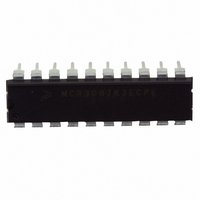MCR908JK3ECPE Freescale Semiconductor, MCR908JK3ECPE Datasheet - Page 119

MCR908JK3ECPE
Manufacturer Part Number
MCR908JK3ECPE
Description
IC MCU FLASH 8BIT RC OSC 20-DIP
Manufacturer
Freescale Semiconductor
Series
HC08r
Datasheet
1.MC908JK1ECDWE.pdf
(180 pages)
Specifications of MCR908JK3ECPE
Core Processor
HC08
Core Size
8-Bit
Speed
8MHz
Peripherals
LED, LVD, POR, PWM
Number Of I /o
15
Program Memory Size
4KB (4K x 8)
Program Memory Type
FLASH
Ram Size
128 x 8
Voltage - Supply (vcc/vdd)
2.7 V ~ 3.3 V
Data Converters
A/D 12x8b
Oscillator Type
External
Operating Temperature
-40°C ~ 85°C
Package / Case
20-DIP (0.300", 7.62mm)
Processor Series
HC08JK
Core
HC08
Data Bus Width
8 bit
Data Ram Size
128 B
Maximum Clock Frequency
8 MHz
Number Of Programmable I/os
15
Number Of Timers
2
Maximum Operating Temperature
+ 85 C
Mounting Style
Through Hole
Development Tools By Supplier
FSICEBASE, DEMO908JL16E, M68CBL05CE
Minimum Operating Temperature
- 40 C
On-chip Adc
8 bit, 12 Channel
Lead Free Status / RoHS Status
Lead free / RoHS Compliant
Eeprom Size
-
Connectivity
-
Lead Free Status / Rohs Status
Details
Available stocks
Company
Part Number
Manufacturer
Quantity
Price
Company:
Part Number:
MCR908JK3ECPE
Manufacturer:
Freescale
Quantity:
289
The vector fetch or software clear and the return of all enabled keyboard interrupt pins to 1 may occur in
any order.
If the MODEK bit is clear, the keyboard interrupt pin is falling-edge-sensitive only. With MODEK clear, a
vector fetch or software clear immediately clears the keyboard interrupt request.
Reset clears the keyboard interrupt request and the MODEK bit, clearing the interrupt request even if a
keyboard interrupt pin stays at 0.
The keyboard flag bit (KEYF) in the keyboard status and control register can be used to see if a pending
interrupt exists. The KEYF bit is not affected by the keyboard interrupt mask bit (IMASKK) which makes
it useful in applications where polling is preferred.
To determine the logic level on a keyboard interrupt pin, disable the pull-up device, use the data direction
register to configure the pin as an input and then read the data register.
12.4.1 Keyboard Initialization
When a keyboard interrupt pin is enabled, it takes time for the internal pull-up to reach a logic 1. Therefore
a false interrupt can occur as soon as the pin is enabled.
To prevent a false interrupt on keyboard initialization:
An interrupt signal on an edge-triggered pin can be acknowledged immediately after enabling the pin. An
interrupt signal on an edge- and level-triggered interrupt pin must be acknowledged after a delay that
depends on the external load.
Another way to avoid a false interrupt:
12.5 Keyboard Interrupt Registers
Two registers control the operation of the keyboard interrupt module:
Freescale Semiconductor
1. Mask keyboard interrupts by setting the IMASKK bit in the keyboard status and control register.
2. Enable the KBI pins by setting the appropriate KBIEx bits in the keyboard interrupt enable register.
3. Write to the ACKK bit in the keyboard status and control register to clear any false interrupts.
4. Clear the IMASKK bit.
1. Configure the keyboard pins as outputs by setting the appropriate DDRA bits in the data direction
2. Write 1s to the appropriate port A data register bits.
3. Enable the KBI pins by setting the appropriate KBIEx bits in the keyboard interrupt enable register.
•
•
register A.
Keyboard status and control register
Keyboard interrupt enable register
Setting a keyboard interrupt enable bit (KBIEx) forces the corresponding
keyboard interrupt pin to be an input, overriding the data direction register.
However, the data direction register bit must be a 0 for software to read the
pin.
MC68HC908JL3E Family Data Sheet, Rev. 4
NOTE
Keyboard Interrupt Registers
119











